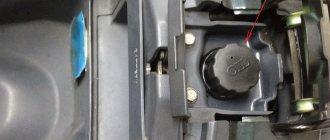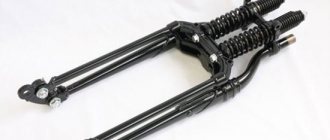Changing the scooter gearbox oil
A gearbox is a mechanism for reducing the speed of the driven shaft in order to increase torque.
Simply put, it converts high clutch shaft RPMs into low (but powerful) wheel RPMs. The gearbox consists of several gears and bearings. All its parts are in constant rotation when driving and are under very serious load. Therefore, the key to long-term performance of the gearbox is good care of it. Fortunately, maintenance is very simple: you need to change the oil in the gearbox in a timely manner. I believe that the oil should be changed once a year or every 2 thousand km.
In order to change the oil in the scooter gearbox, we will need the following tools:
- container for draining old oil
- key for 10
- a syringe or, at worst, a funnel
- transmission oil
What to fill the gearbox with?
There are three options.
1. There is a special Motul Scooter Gear gear oil. That's what I used at first. The disadvantages of this oil are as follows: the tube has a volume of 150 ml, while in my scooter the gearbox requires 90 ml, that is, one tube is one and a half refills, neither this nor that. And it is inexplicably expensive (about 250 rubles). The only plus: the convenient tube spout.
However, you can use any other automotive gear oil with a viscosity of 80W-90 or 75W-90. For the same money you can buy a liter of “non-scooter” oil, and it will work exactly the same.
2. Since the scooter gearbox does not contain hypoid gears, any motor oil with a viscosity of 10W-30 can be used as transmission oil. Motor oil is even preferable if the scooter is used in the off-season at temperatures below +7 ° C, because it is more liquid.
3. And finally, the most optimal option, in my opinion, is oil for automatic transmissions (ATF), that is, ATF transmission fluid. This oil has the best fluidity (which is especially important at low temperatures, although this is not so important on a scooter), it perfectly protects gears, and has a reduced tendency to foam. Oh yes, it also has a beautiful red color :). The price range for ATF is from 170 to 700 rubles per liter, and for a scooter you can take the cheapest one.
How to drain old oil
First of all, the oil should be changed after a trip so that the sediment rises from the bottom. If your scooter is cold, you can rev it up for a few minutes on the spot.
If the scooter has a drain bolt, everything is very simple: put a container under it, unscrew it, drain the oil, tighten it.
If there is no drain bolt (like mine), then draining and filling is done through a single bolt. In this case, the scooter must be tilted on its side to drain the oil.
If you haven't changed the oil in a while, it will look something like this:
The metallic color indicates abrasion of the working surfaces of the gears. But it’s not scary, it’s a normal process.
How to add new oil
The oil volume is indicated on the gearbox housing. For example, mine says “OIL 0.09 L”, i.e. 90 ml.
It is most convenient to measure and fill the indicated volume using a medical syringe (buy the largest one, at least 20 ml). But if you don’t have a syringe, you can simply fill the oil to the lower thread level of the filler bolt. This is just the right amount. Of course, the scooter must be in an upright position.
When tightening the bolt, do not use excessive force, since the motor housing is made of silumin, the threads are very easy to twist.
Please note: This article and the images in it are subject to copyright. Partial or complete reproduction on other resources without permission is prohibited.
Scooter with four stroke engine
For scooters with a regular gearbox, 4t oil is suitable, but if your scooter has a CVT gearbox, then you need gear oil. In the case of a 4t scooter, the choice of oil comes down to the same principle as for a 2t. That is, it all depends on the riding style, the technical condition of the moped and also its age. If we talk about four-stroke mopeds, then it is recommended to fill them with 10w-40 oil. In principle, a moped can run on regular car oil, but use such oil at your own peril and risk. The oil must protect all rubbing parts well, and there are a large number of them in the engine. And the scooter clutch especially needs high-quality oil, since it literally floats in oil.
If we are talking about what kind of oil to pour into cubic capacity motorcycles, then two-stroke synthetic is better. This way the cylinder-piston group will remain clean and well preserved. This oil is the most resistant to various temperatures. Also, synthetic scooter oil produces less soot, which settles in the muffler and clogs it.
Why change the oil
I met a person who did not change the oil for 3 seasons. His ATV was being repaired and there was little left of the oil, everything was covered in soot. And the engine was working in this one, it’s good that it was still working at all. But it significantly reduced its service life, and the repairs cost a pretty penny.
As mentioned, a good synthetic oil prevents the formation of carbon deposits and is resistant to temperatures. Carbon deposits interfere with engine operation and reduce its service life, complicate the life of compression rings and cause overheating. And given that the amount of carbon deposits is constantly increasing, plus constant overheating, repairs will not take long. And expensive motorcycles require expensive repairs. Therefore, it is not recommended to skimp on oil.
The first time you should change the oil after 500 km, then every 1000. It is also recommended to change the oil after carrying out work on the cylinder: replacing the cylinder, removing the cylinder head, etc., since during these works, even if everything was done carefully, there is a possibility dirt and metal particles getting into the engine. You will need a wrench with a head (most likely 19).
The oil change must be carried out when the engine is warm - this way the oil becomes more fluid, and dirt, if any, rises from the bottom of the crankcase, mixing with the oil. The scooter must be placed on the center stand.
Work order:
- Unscrew the filler cap (dipstick), located on the right side of the engine, next to the generator
- Place a container (about 1 liter) under the drain hole to drain the used oil and unscrew the drain plug counterclockwise. To unscrew, use only the head - an open-end wrench can damage the drain plug, which is made of aluminum. Under the plug there is a spring and an oil filter - mesh
- Drain the oil
- Wash the drain plug and filter in gasoline
- Screw in and tighten the drain plug. Don't overdo it - remember that the plug and crankcase are made of aluminum. Excessive force may damage the threads.
- Pour 800 ml of engine oil into the engine through the filler neck using a suitable funnel.
- Tighten the filler cap
How much oil is in a scooter gearbox?
When it’s time to change the oil in a scooter and it’s the first time for the scooterist, or he’s never done it before, but now it’s necessary. Then the question arises, how much oil is in the scooter gearbox?!
How much oil is in the gearbox
Each scooter has a different gearbox volume. This means a different volume of oil in the scooter gearbox. How to find out how much oil is in a scooter gearbox?! Very simple. This can be easily checked even if you don’t have a manual for the scooter.
How much oil is in the scooter gearbox is written on the gearbox itself.
If everything is really bad and you cannot read on the gearbox itself for various reasons, then you can ask in the comments.
Changing the oil in a scooter gearbox
A gearbox is a mechanism that reduces the speed of the driven shaft, which increases torque. In other words, it converts high clutch shaft speeds into low, but very powerful wheel speeds. On average, this equals - for one revolution of the rear wheel there are 12.28 and 11.3 revolutions of the driven pulley, respectively. It consists of bearings and gears. When moving, all elements of the gearbox constantly rotate, so they bear a large load. To ensure long service life of the gearbox, you should take good care of it. This care includes an oil change, which needs to be done approximately once a year or every 2 thousand kilometers.
To change the oil in a scooter gearbox, you will need the following tools:
a container into which you can drain used oil with a key for 10 syringes or, but you can get by with a funnel
So what should the gearbox be filled with?
There are three options for refilling it. There is a special Motul Scooter Gear transmission oil on sale. The disadvantages of this oil are the following: the tube holds only 150 ml, in many scooters the gearbox holds 90 ml, which means there will be one and a half refills in one tube, neither here nor there. And the price for it is quite significant at around 250 rubles. One of the advantages is the very convenient spout in the tube.
But you can use other automotive gear oils with a viscosity of 80W-90 or 75W-90. For the same amount you can buy a whole liter of non-scooter oil, which will work just as well. 2. Taking into account the fact that the scooter gearbox does not contain hypoid gears, motor oil with a viscosity of 10W-30 can be used as gear oil. And if the scooter is used in cold conditions at temperatures below +5 ° C, engine oil will be more suitable, since it is thinner.
In our opinion, the best option is the oil used in automatic transmissions of cars (automatic transmissions), it is called ATF transmission fluid. This oil has the best fluidity, which makes it simply irreplaceable at low temperatures, although this is not so important for scooters. Having excellent protective effects of gears, it foams minimally. The price of such ATF oil ranges from 170 rubles per liter. For scooters, the cheapest one will do.
How to properly drain old oil
It is very important that the oil change is carried out immediately after the trip, then all the sediment will rise from the bottom of the gearbox. You can also start the engine and let it run until it warms up.
It's much easier if you have a drain bolt. We place the prepared container under it, unscrew the bolt and drain the oil completely, then screw it back.
What kind of oil is poured?
Many people are interested in what kind of oil to pour into the gearbox of a walk-behind tractor? To answer this question, you need to take into account several factors, the main one of which is the manufacturer's recommendation regarding the type of oil.
In the store you should also pay attention to the degree of viscosity of the oil, which is indicated on the packaging. In addition, there are special additives - substances that increase the beneficial properties of the lubricant.
Gear oil
In general, oils can be of various types:
- SAE. These types of oils cope very well with sudden temperature changes, so they can be used all year round.
- The selection process is as follows: you need to look at the number in front of the letter W - a lower value will indicate that the oil is very well adapted to low temperatures (the smallest is 0W). If the letter W is not on the label, then this oil is suitable for the summer period.
- API. In this case, the letters in the marking will indicate the type of engine - gasoline or diesel. Accordingly, a certain letter will indicate that the oil is suitable for gasoline units, and another – for diesel units.
- The numbers will indicate the type of engine, i.e. number 4 means the oil should be used for a 4-stroke engine, etc. The EC value is the degree of energy conservation, i.e. The higher the value, the better the quality of the oil.
- ASEA. The highest number in the labeling will indicate that the oil can function in very difficult conditions.
- GOST 17479, 1-85. These indicators characterize the degree of viscosity of the oil. As a rule, alphabetic and numerical values are written after this parameter, and their absence indicates that the oil is universal.
Transmission oils for filling into gasoline and diesel walk-behind tractors
As for the gearbox, transmission oils must be used to fill it. For example, a good choice would be semi-synthetic oil ZIC 10W40, intended for gasoline and diesel walk-behind tractors. API indicator – SM/CF, ACEA – A3/B3, A3/B4, C3.
Another decent oil is Super T-3 85W-90 from Gazpromneft. Its technical data will be as follows:
- API indicator – GL-5;
- viscosity degree – 85W90;
- temperature indicator of loss of fluidity – -280C;
- flash point – 2170C;
- package length – 270 mm;
- packaging width – 130 mm;
- packaging height – 240 mm.
This gear oil is also supplied in 4-liter containers, the cost of which is approximately 600 rubles.
Transmission oil
This is not the entire list of oils that can be poured into the gearbox of a walk-behind tractor. In principle, anyone who has become familiar with the basic parameters of the oil can independently determine what is needed for their walk-behind tractor.
How to change the oil in a scooter gearbox?
Changing the oil in the scooter gearbox should be carried out according to the recommendations specified in the special description. If there are no instructions, an initial replacement should be made after 300 km, a secondary replacement should be performed after 1500 km. All subsequent ones - every 2000 km. You can service the scooter gearbox yourself, change the oil in a timely manner and check its level with a dipstick.
The first oil change on a scooter should be changed after 300 km.
How to make a replacement?
It is better to change this component immediately after the trip. In this state, it is warmed up and will flow out perfectly, which will ensure a minimum residue of old fluid in the gearbox. You should take the brand recommended by the scooter manufacturer. You also need to strictly adhere to the recommended volume.
The required oil volume can be seen on the gearbox.
To replace, place the vehicle level on the main stand. Next, you need to unscrew the drain bolt (if there is one) and wait until all the liquid is drained into a specially prepared container. If there is no such bolt, drainage is carried out through a single bolt. To do this, you need to tilt the scooter on its side. It is worth noting that the oil, which has not been changed for a very long time, has a dark blue color, close to black. But if you notice that the liquid has a metallic color, this means that abrasion has occurred on the working surfaces of the gears. But it’s not so scary, there’s no need to worry. This will not affect the operation of the vehicle in any way. After this, you need to tighten the drain bolt and unscrew the filling hole.
The required volume is most often indicated on the element of the rear gearbox (numbers are stamped). If nothing is specified, carefully read the description of the scooter. Typically, the amount of oil for a scooter whose engine volume does not exceed 50 cm³ is 100 g. You need to take the liquid into a syringe, preferably one with a 20 ml capacity, and pour it into the gearbox. If there is no syringe, oil must be filled to the lower level of the thread of the filler bolt. This is exactly the mark (maximum correct volume). Replacement should only be done with the scooter in an upright position. After the component is poured, the working surface must be wiped with a dry, not dirty cloth and the screw must be tightened.
Return to contents
To accurately change the oil, you need to use a watering can.
Automotive oils are divided into all-season, summer and winter. They differ in composition. For understanding and the opportunity to purchase exactly what you need, it is marked with Latin letters and numbers. The marking of winter automobile oils must contain the letter “W” (in English, winter). The numbers in the abbreviation indicate viscosity. The higher the indicator, the greater the consistency (viscosity) and, accordingly, vice versa.
Maximum viscousness suitable for use in hot summer periods. You should not pay attention to the letters SAE in the abbreviation. These letters indicate the classification of motor oils, which for scooter owners means nothing other than the viscosity indicator. You need to know that if the oil is marked with SAE letters and numbers, you can safely buy it for pouring into a scooter gearbox in hot weather. If the letter W is present, the oil is suitable for winter.
Return to contents
When you choose oil for a scooter gearbox, the question often arises, which is better in terms of base quality, composition and price.
All oils are divided into three types based on their base:
- synthetic;
- semi-synthetic;
- mineral.
The choice of oil depends on the season.
The synthetic type includes those whose packaging bears the designation Fully Synthetic. Such components retain their original properties more than others and are resistant to overheating and low temperatures.
Semi-synthetic is most suitable for engines with considerable mileage. Semi-Synthetic - this is how semi-synthetic fluid is usually designated. There are impurities, which makes the cost of products lower and the quality worse (when compared with synthetic ones).
Mineral is designated Mineral. The cheapest, as it is a product of oil waste. These components tend to thicken quickly and, when boiling, leave deposits on the engine.
Mixing different based components is not allowed.
Return to contents
It is necessary to change the oil only when the scooter is warm.
WE RECOMMEND TO SUBSCRIBE TO THE CHANNEL
What kind of gasoline should I use?
This is the first problem that absolutely all scooter owners face. According to the passport, you need to fill it with an octane number higher than 90. In our area you can most often find 92 or 95. In principle, 92 will be enough (it contains the least amount of additives that “catch up” the octane number to the required one). The exception will be those scooters in which any gasoline below 95 is contraindicated, so it’s worth looking into your specific model once. Incorrectly selected gasoline can cause a number of problems: from contamination of the carburetor and fuel level sensor, and even to failure of the entire fuel system.
What kind of scooter oil?
2 stroke engine:
In a two-stroke engine, oil is dissolved in gasoline. The main task of which is to provide an oil film for rubbing parts and burn - leaving behind a minimal amount of combustion products.
You shouldn’t be “overthinking” with your choice. Among the relatively inexpensive oils, you can easily find fairly high-quality ones that can be safely refilled.
4-stroke engine:
When choosing oil for a four-stroke engine, you should consider:
- Scooter mileage
- Climate in which the engine will be used
- Engine speed
In the first case, if the engine resource is exhausted and the time for a major overhaul is approaching, experts recommend a mineral base and thicker oils.
I would combine the second and third options and draw the following parallel: if the engine constantly suffers from high speeds or temperatures, you should fill in a thicker lubricant product, which will retain its properties when heated. Conversely, “low-viscosity” oils are poured into engines with moderate climates and non-sporting characteristics. An undeniable advantage of such a lubricant will be its high penetration ability (penetration into metal at the molecular level). This property will give the motor of your scooter a longer life, and you will have a minimum of hassle with repairs.
All-season oils include those that are designated by two digits through W in the SAE classification.
Additives in oil:
In fact, there are not many types of additives used in the production of oils for 2 and 4 stroke engines. We can list a few:
Corrosion protection - special attention to protection during downtime, and naturally during operation. Protection against oxidation - we are dealing with the resulting property of the oil to neutralize the effects of high-temperature and chemical conditions on the lubricant
processes occurring inside the engine, preventing the oil from “aging” ahead of time
Protection against oxidation - we are dealing with the resulting property of the oil to neutralize the effects of high-temperature and chemical influences on the lubricant. processes occurring inside the engine, preventing the oil from “aging” ahead of time.
Reduced dispersion - saves rings from sticking by reducing the concentration of resins and, as a result, no contamination of spark plugs.
Neutralizer for high pressure and wear - includes a detergent additive that will contain burnt particles in suspension (preventing them from settling on the walls throughout the entire period of oil operation), adding strength to the oil film, thereby reducing friction.
Conclusion:
Based on the above (incomplete) list of additives used in two- and four-stroke scooter engines, we can conclude that adding additional additives is very unwise. There is only one reason - everything that the oil needed for good performance properties was included in the recipe class=”aligncenter” width=”402″ height=”414″[/img]
Advice:
Fans of 4-stroke scooters often use conventional automotive semi-synthetic SAE 10W-40 because... their formula is largely identical, the benefit is that there is no need to buy oils for different purposes for a car and separately for a two-wheeled pet.
Scooter gearbox - design and principle of operation, oil change
The article describes the design and operating principle of a scooter gearbox .
What is a gearbox? A gearbox is a set of gears housed in one common housing called a crankcase. The presence of a crankcase allows for compact arrangement of gear parts, protects parts from mechanical damage and contamination, and provides the necessary lubrication.
What is a gearbox used for? And it is needed to change the speed of rotation of the shafts, down or up.
Gearboxes are installed on all scooters between the output shaft of the automatic centrifugal clutch (read an article about it here) and the wheel.
Figure 1 shows the entire powertrain of the scooter. Circled in red is the gearbox housing 1 with a block of gears 2, 3 and 4. This gearbox is of the two-stage cylindrical gear type, has a fairly high gear ratio and reduces the speed of shaft 4 with wheel 5 several times, while increasing the traction force almost as many times .
And now about the device. On the primary shaft 2 of the gearbox there is a driven pulley of the variator and a centrifugal clutch, and torque from them is transmitted to the same shaft. Next, the torque is transmitted to the intermediate shaft with the gear block 3 and then to the secondary shaft 4 on which the wheel 5 is located. The required amount of engine* (note the article is saved in its original form, but transmission oil is poured into the gearbox) oil for lubrication is poured into the crankcase 1 gears
There are also gearboxes that are of the single-stage cylindrical gear type. The principle of construction of such a gearbox is shown in Figure 2. In it, in the crankcase 1, there are only two shafts instead of the three described above: primary 2 and secondary 3. On the secondary shaft 3 there is a wheel.
Also, in all gearbox housings there is a hole for simultaneously filling and draining oil. Some models have a separate oil drain hole located at the bottom of the crankcase. The role of the filler plug is performed by a simple bolt and washer. The amount (volume) of oil to be poured is often written on the crankcase itself, not far from the plug, and generally for 49 cm3 scooters it is 90-100 grams.
Once a season , check the presence of oil in the crankcase . In the absence of oil or its low level, an unpleasant hum begins to appear on the side of the gearbox, which leads to rapid wear of bearings and bushings.
Benefits of this oil
Keep in mind that in comparison with most synthetic products from other brands and manufacturers that are made on a hydrocracking basis, this product has an excellent ester base, which ensures operational stability. Also, SCOOTER oil is based on the maximum list of calcium and boron additives: including product analyzes do not show an increase in the amount of aluminum in the lubricant, which is why the wear rate of the pistons will be at the lowest level.
It would also be worth noting that modern SCOOTER lubricants already have a reputation as the most reliable among all - still, the oil was created specifically for scooters with four-stroke engines.
Among the advantages of the lubricant: it is able to maintain the viscosity indicator over time throughout the entire operation of the engine, without going beyond the established norm; the oil also demonstrates better ash content and an almost complete absence of deposits when used.
The viscosity indicator of the composition makes it possible not to worry about the level of performance of the scooter even at normal replacement intervals.
Scooter gearbox
The job of a scooter gearbox is to transmit rotation from the driven pulley of the variator to the rear wheel. The first gear ratio goes straight through the CVT. The CVT reaches its final ratio (the belt in front goes to the outer radius) by rotating the driven pulley about 5 times per crankshaft rotation (at 10,000 engine rpm, so 50,000 pulley rotations). Presumably, if the wheel were sitting on a driven pulley, then the wheel would have to make 5 full rotations with each ignition (corresponding to the rotation of the crankshaft). The result would be such a long ratio that the motor would not be able to pull. Thus, the importance of the gearbox becomes obvious: by transmitting torque from the driven pulley to the rear wheel, it reduces the rotation speed. How many times? On different scooter models this number may differ slightly, but it is always close to 12, for example on the Yamaha Aerox, to be precise, 12.28, and on the Chinese Baotian Tanco 50 about 11.3. This means that for one revolution of the rear wheel there are 12.28 and 11.3 revolutions of the driven pulley, respectively.
The gearbox gears are located in a closed container at the rear of the scooter housing. The container is filled with oil, so the oil must be drained before opening the lid.
The scooter's gearbox mechanism is divided into primary (gears 1 and 2) and secondary (gears 3 and 4) gears. Primary or secondary gears always consist of two gears - large and small. By dividing the number of teeth on the drive gear by the number of teeth on the driven gear, we obtain the gear ratio. For example, the small and large primary gears (1 and 2) of the Yamaha Aerox have 13 and 52 teeth, respectively. It is clear that the drive in this case is the small gear, so the gear ratio will be equal to 13/52, or 1:4 if we divide the numerator and denominator by 13. For us, this means that for every four revolutions of the drive (small) gear there is only one slave revolution (large). Knowing the sizes of the secondary gears (3 and 4) of the same Yamaha Aerox - 14 and 43 and acting in a similar way, we obtain a ratio of 1: 3.07. Now all that remains is to multiply the resulting ratios 1:4 and 1:3.07 to get the final ratio of the Aerox gearbox 1:12.28 - it was mentioned at the very beginning.
The lower the gear ratio, the longer the transmission. For example (for primary gear), 1:4.2 - short gear; 1:3.15 - medium gear; 1:2.73 - long pass; 1:2.11 - very long pass.
It makes absolutely no difference which gear - primary or secondary - is used to change the final ratio of the gearbox. On scooters prepared for competitions based on High-End piston engines, sometimes even both gears are replaced.
How to properly change the oil in a T4 scooter gearbox?
Any vehicle needs periodic maintenance. A scooter is not as complex a piece of equipment as a car, but it also requires constant care. One of the operations on which reliable movement depends is changing the oil in the T4 scooter gearbox.
The list of main components of a scooter includes a gearbox. During movement, the unit is subject to heavy loads. If you do not change the transmission oil in a timely manner, premature wear of parts may result in further failure.
A scooter's gearbox consists of rubbing gears and bearings that constantly receive enormous load. To avoid their rapid wear, you should monitor the presence of lubricating fluid in the unit. Thanks to the high-quality liquid, which contains various functional additives, all parts of the element will be protected from rapid wear, jamming and corrosion.
Gearbox oil change timing
That is why, for reliable operation of the scooter as a whole, it is necessary to observe the timing of fluid replacement. In most cases, the frequency of oil changes and the recommended lubricant class are indicated in the manufacturer's instructions. If there is no information about the timing of the change, the oil in the scooter gearbox is changed every three to five thousand kilometers or once a year.
A sufficient oil level in the gearbox reduces shock loads, vibrations and extraneous noise. Due to the enormous loads on a Chinese scooter, constant care of the vehicle is required. After a certain time or mileage, the oil loses its quality, becoming saturated with metal elements and forming sediment. And this will lead to a deterioration in the lubricating properties of the fluid, without providing reliable protection. Without sufficient fluid in the gearbox, this part may quickly break down.
When purchasing a new vehicle, changing the oil in the gearbox on a scooter is done more often. The first fluid change on a new scooter is carried out after 300 km, and the second time after 1000 km. But the quality and reliability of driving a moped also depends on the required oil level in the gearbox. In order for the level to comply with the standards, it is necessary to check it every 2.5 thousand kilometers and, if necessary, top up the fluid.
Gearbox design in the T4 scooter
The gearbox consists of a set of gears, which are located in a common housing - in the crankcase. Thanks to the presence of the crankcase, all parts are located compactly. The crankcase protects all elements from mechanical damage and contamination, providing good lubrication of gearbox parts.
A gearbox is necessary to adjust the speed of rotation of the shafts down or up. On a scooter, this element is located between the secondary clutch shaft and the wheel.
The gearbox is divided into primary and secondary gears:
- The primary gear is the first and second gears.
- The secondary gear includes the third and fourth gears.
Both gears always consist of two gears - one large and the other small.
There is a hole in the gearbox housing for draining and filling fluid. The filler plug is just a regular bolt and washer. Transmission oil is poured into the scooter. It is advisable to check the fluid level in the crankcase once a month.
If the oil level has dropped or is completely absent, the gearbox begins to make an extraneous noise. Extraneous noise is produced by worn gears with a small amount of lubricant. And this will lead to wear of gears, bearings and bushings.
Draining the oil and flushing the gearbox
So, having selected the right lubricant for the regulator, you can begin to drain the old oil. Changing the scooter oil in the gearbox is carried out when the scooter is warmed up. To do this, it is enough to ride a scooter for 20 minutes before the change process. The heated liquid becomes more liquid, and this will help quickly drain the waste along with dirt or metal debris.
Draining the oil and flushing the gearbox:
- Wipe the drain and filler (bolt) holes with a clean rag.
- The filler hole is located at the rear of the power unit.
- Unscrew the nuts from the filler bolt, and then from the drain hole.
- Substituting an empty container, drain the old liquid.
- While the old oil is draining, wash the removed nuts and bolts in gasoline.
If metal particles are found when draining the old oil, the regulator housing should be flushed. To do this, remove any remaining lubricant from the crankcase and fill in transmission oil to flush it. The viscosity of the flushing fluid should be higher.
To flush the gearbox housing, you must:
- Tighten the drain bolt and then the filler hole.
- Start the power unit and rev it up a little.
- Drain the washing mixture.
- Tighten the drain hole.
This completes the process of draining the old fluid from the scooter gearbox. Changing the oil in the gearbox of a 4t 50q scooter is completed by filling in new fluid.
Filling with new oil
After draining the old lubricant and flushing the gearbox system, all that remains is to fill the transmission oil. Moped manufacturers recommend using the following modifications 75W90, SAE 80W90, 85W90 with API quality class: GL-4; GL-5.
The required volume of lubricant is always indicated on the gearbox. Use a large syringe to take the required amount of oil and pour it into the filler hole.
If you don’t have a syringe, you can simply fill the liquid to the lower level of the filler hole. The vehicle must be in an upright position when filling the oil. After pouring oil into the T4 scooter gearbox, wipe the filler bolt and plug dry. Carefully tighten the filler bolt and check the tightness of the connections.
In conclusion, I would like to note that the long-term performance of the scooter gearbox depends on regular maintenance such as timely replacement of transmission fluid.
Posts 1 page 4 of 4
Share1Wednesday, March 23, 2011 10:09
- Author: Basilisk
- Forum Administrator
- Posts: 249
- From: Khabarovsk
- Phone: 66-73-77
- Registered: Saturday, March 12, 2011
- Time spent on the forum: 6 days 18 hours
- Last visit: Saturday, April 14, 2021 23:02
- Respect: [+2/-0]
- Positive: [+8/-0]
- Age: 28 [1991-11-22]
- Gender: Male
Q. What kind of oil should I put in the scooter gearbox? A. Any transmission with a viscosity of 80W90. Automatic transmission oil is not suitable. Synthetic is better than mineral. The manufacturer doesn't matter. Change after 10,000 km. or once a season.
Q. How to change the oil in a scooter gearbox? A. If the gearbox has 2 holes closed with plugs, then the top one is the filler hole, and the bottom one is the drain hole. Sometimes the drain is located under the variator cover. The oil is drained from below, then diesel fuel is added. The scooter is allowed to run on the stand for about five minutes, lightly accelerating so that the rear wheel spins. After this, the diesel fuel is drained and oil is added. If there is only one hole, you can suck the oil out with a syringe through a dropper or turn the scooter over so that the oil spills out. The oil volume is indicated on the gearbox. If this number is not present, the filler hole serves as a level.
Q. How to break in a scooter after replacing the piston? A. Violent discussions of this topic take place 2-3 times a month. Opinions are polar. Let's look at the following. Good running-in is the key to long engine life. For the first 300-500 km, you should not unscrew the throttle more than halfway. Up to 1000 km, you don’t need to drive faster than 50 km/h and speed up unnecessarily. It is also advisable to add oil to gasoline during the break-in period and not to carry a passenger. You can read more about this, as well as about various exotic methods, below. Q. What kind of oil should I put in the oil tank? A. Special “for two-stroke engines and separate lubrication systems.” It is advisable not to mix different varieties. For low-powered Japanese engines, semi-synthetics are better, for European and tuned engines - synthetics. To save money, you can use mineral water, but the benefits of this are questionable. By an obscure quirk, most MSC members prefer MOTUL and LIQUI MOLY. An example of a lively discussion can be seen below. Q. How to maintain the scooter air filter? A. Quite simple. If you do not have a FNS (zero resistance filter), then maintenance consists of regularly cleaning the foam element and impregnating it with special oil. It is possible to use another oil, but it is unwise, because... A special jar for $10-15 is enough for more than one season. The technology is described in detail below.











